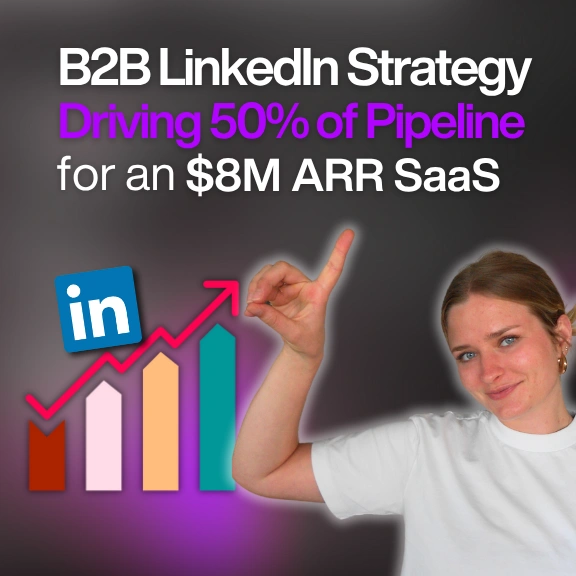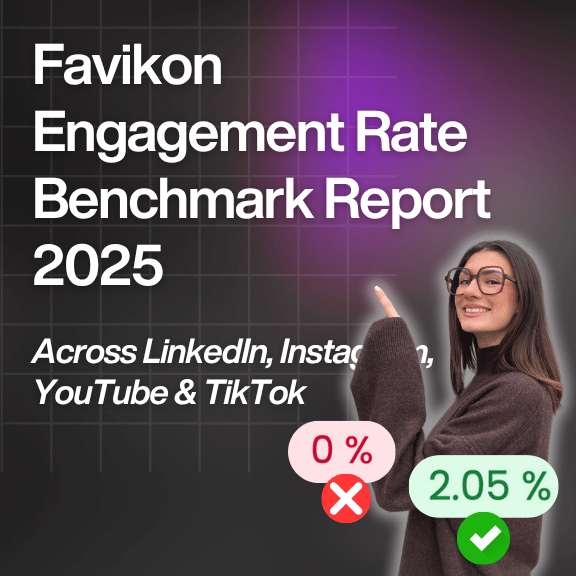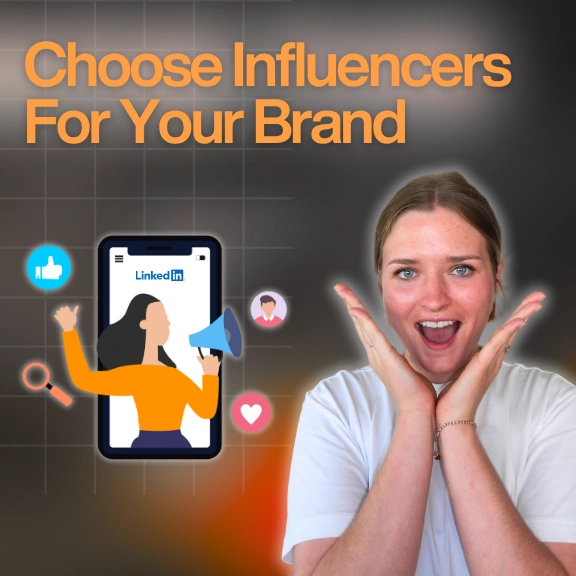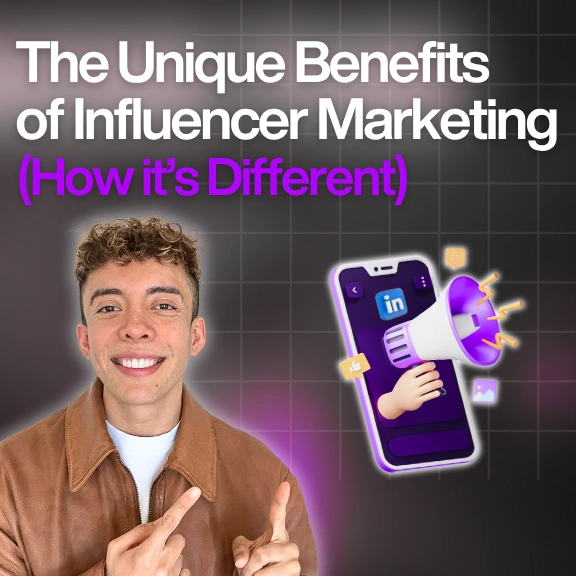Blog e artigos
Seu recurso definitivo para a economia do criador
Metodologia e classificações
Sobre o Favikon, classificações, ferramentas e muito mais.
Percepções
A receita por trás dos rankings virais e cobiçados da Favikon.
Ferramentas gratuitas para potencializar seus fluxos de trabalho de marketing de influenciadores.
Veja as histórias de sucesso dos usuários do Favikon.
Tenha acesso a todos os rankings da Favikon.
Torne-se um parceiro
Torne-se um afiliado
Sobre a equipe por trás do Favikon
O lugar para conversar economia do criador, juntos


Classificações em destaque

Here is the Top 50 Rising Video Creators on LinkedIn. Video is quickly becoming the platform’s most powerful format, with creators gaining more reach and engagement than ever. As Gen Z grows its presence and tools like BrandLink and Thought Leader Ads support content creation, LinkedIn is doubling down on video. This ranking, made in partnership with OpusClip, celebrates the creators leading this shift and aims to inspire anyone ready to start sharing through video.

Here is the Top 50 Rising Video Creators on LinkedIn. Video is quickly becoming the platform’s most powerful format, with creators gaining more reach and engagement than ever. As Gen Z grows its presence and tools like BrandLink and Thought Leader Ads support content creation, LinkedIn is doubling down on video. This ranking, made in partnership with OpusClip, celebrates the creators leading this shift and aims to inspire anyone ready to start sharing through video.
Youtube Influencer Marketing Guide
YouTube influencer marketing offers powerful SEO visibility, deep audience trust, and long-lasting content impact. This guide breaks down costs, campaign types, and proven strategies to give marketers a clear, practical roadmap for scaling results through YouTube collaborations.
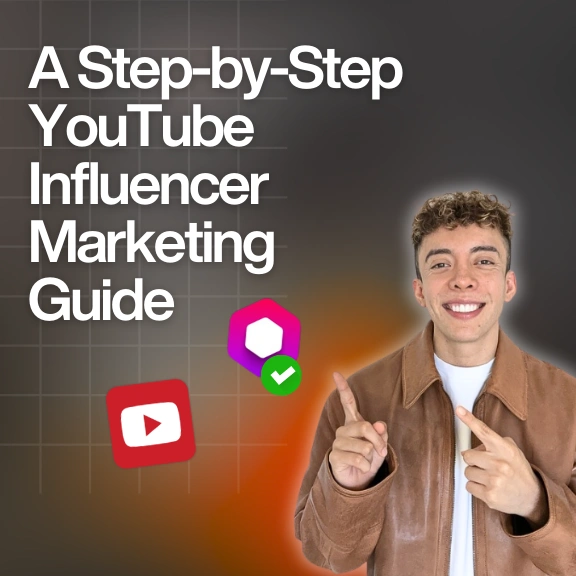


Megan Mahoney is an influencer marketer who uses data and real-world case studies to uncover what actually drives results in influencer campaigns. With a background in content marketing and over a decade of experience helping brands grow through strategy and storytelling, she brings a thoughtful perspective to creator partnerships and is deeply engaged in the evolving creator economy.
Check Brand DealsA Step-by-Step YouTube Influencer Marketing Guide
Plenty of established marketers and founders claim that YouTube influencer marketing is incredibly valuable.
For example, Sean Frank of Ridge Wallet has spent over $10 million on influencer marketing and says YouTube is the most valuable channel.

In this post, we’ll analyze the pros and cons of YouTube influencer marketing and discuss a step-by-step strategy so that you can implement an effective YouTube influencer marketing strategy.
What Are The Pros and Cons of YouTube Influencer Marketing?
Pro: LLM and SEO Visibility
YouTube is the second-largest search engine (after Google), and many LLMs also use YouTube to discover products and services to suggest to their users.
For example, if you want to show up for the keyword “how to build a website,” you can sponsor a variety of YouTube creators to make videos targeting that and related keywords. In the video, they can discuss your product and how to use it to accomplish that task.
In fact, this is the strategy that Sarah Adam of Wix is currently using to improve Wix’s visibility in LLMs and Google Search results for queries related to “best website builders.”
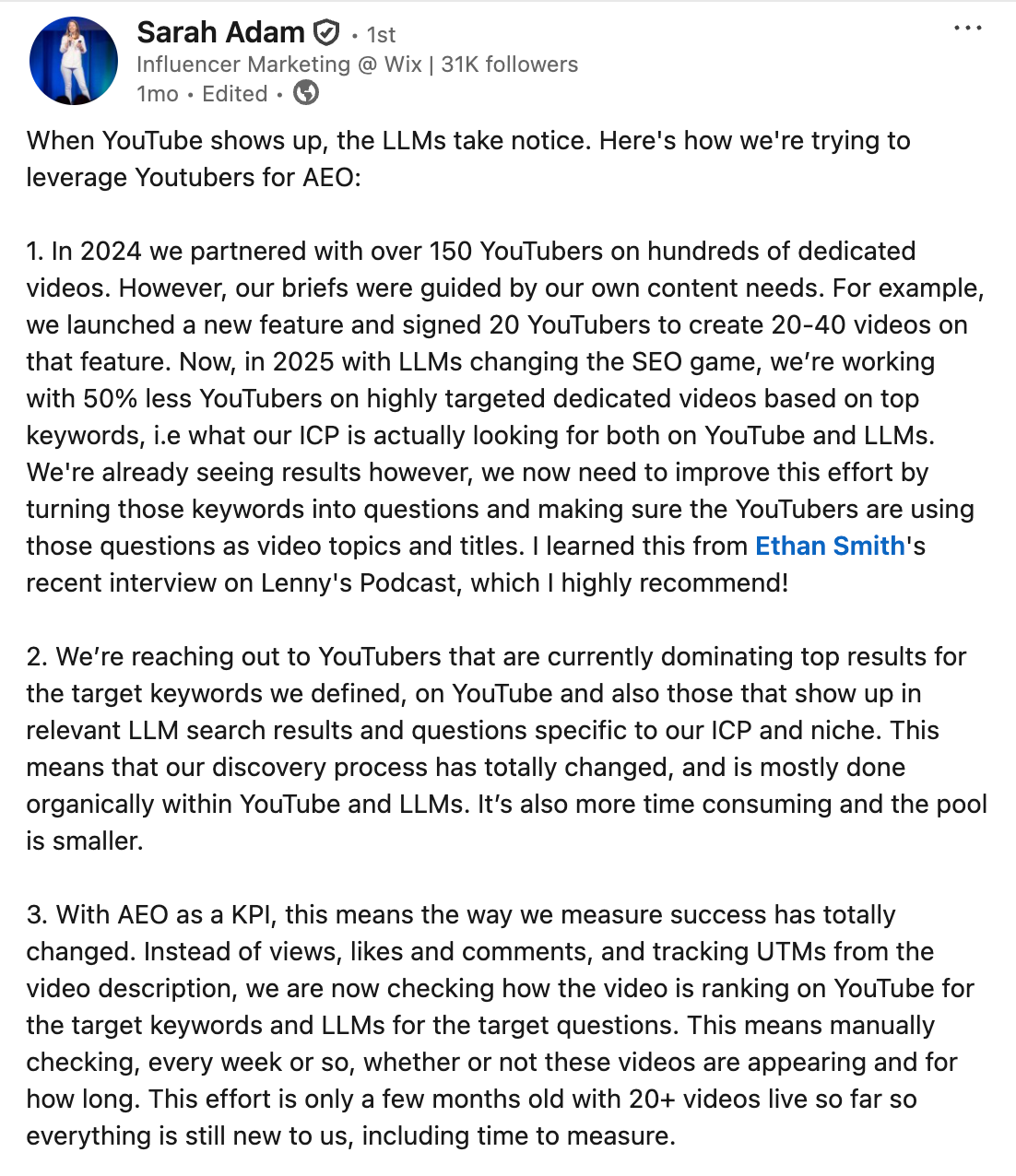
And, a recent study from Search Engine Land shows that YouTube is cited 200 times more frequently than any other video platform.
Pro: Depth of Audience Trust
Long-form YouTube videos allow the audience to get to know the creator on a more personal level.
Therefore, YouTube creators often have deeper trust with their audience, which ultimately means you'll likely see a higher conversion rate on YouTube compared to other platforms.
Pro: Detailed Product Explanation
Some products are complicated and can't be explained in a matter of seconds.
Long-form video content is a great solution to this problem as the creator can take the time to explain the product in depth and show it in action.
This was a key benefit mentioned by Adelė Grigūnaitė, the head of influencer marketing at Omnisend.

Even if your product is easy to understand, long-form content can still be beneficial as it allows the creator to demonstrate your product's unique benefits and differentiators.
This is particularly important if you're advertising a product in a "red ocean" market.
Pro: Ability to Repurpose Content
Another benefit of YouTube is that long-form video can be repurposed into short-form and text-based content across other platforms.
Kristen Sesto (founder of Custom Influence, a B2B influencer marketing agency) cited repurposing options as the main benefit of YouTube influencer marketing.

Pro: Evergreen Nature of YouTube Content
Unlike most social media content, which is rarely seen again after the first week or so, YouTube content is discoverable months and even years after it was initially published.
In fact, Igor Gorbenko, who leads influencer marketing at Ahrefs, noted that they often see sales from YouTube videos months after the video is published.
Specifically, they have a field that asks "how did you hear about us?" after the checkout page, and YouTube is frequently cited months after the campaign launches, whereas LinkedIn and newsletter campaigns are not.

Con: Low Audience Retention
If an Instagram or TikTok creator makes a video about your product, anyone who sees the video sees your product.
However, because YouTube videos are long and not every viewer watches until the end, you can't be sure how many people actually saw your ad.
The exception to this is if you pay for a dedicated video, where the creator exclusively discusses your product. However, dedicated videos are often significantly more expensive.
Con: Beginner Audience
YouTube is known for its tutorial-style content, which tactically guides people through a step-by-step process.
However, brands selling to advanced audiences who don't intend to execute a process themselves (e.g., executives and high level decision makers) likely aren't active on YouTube.
This was the case for Adelė Grigūnaitė of Omnisend.

Con: High Cost
YouTube is often the most costly influencer marketing channel due to the resources required to script, film, and edit a long-form YouTube video.
Therefore, a YouTube video must drive significantly more sales than a video or post on another platform (assuming all other variables are equal).
We'll discuss in more detail exactly how much YouTube influencer marketing costs below.
How Much Does YouTube Influencer Marketing Cost?
Unfortunately, there is no standard base cost for YouTube influencer marketing.
This is because the price of a video varies depending on:
- The type of video (dedicated versus an integration)
- The creator's niche
- The scope of the partnership
This is why most generic industry averages aren't always very accurate.
Instead, here's recent data from Brandon Pourmorady, who runs the YouTube influencer marketing agency, Adhesive Media.

Additionally, here is pricing data (supplied by Sarah Adam) for a dedicated video reviewing Wix products.

As you can see, these prices range from as low as $2,250 to $30,000, so expect prices to vary dramatically.
If you’re curious about the factors that impact price, here are some insights from Brandon Pourmorady:
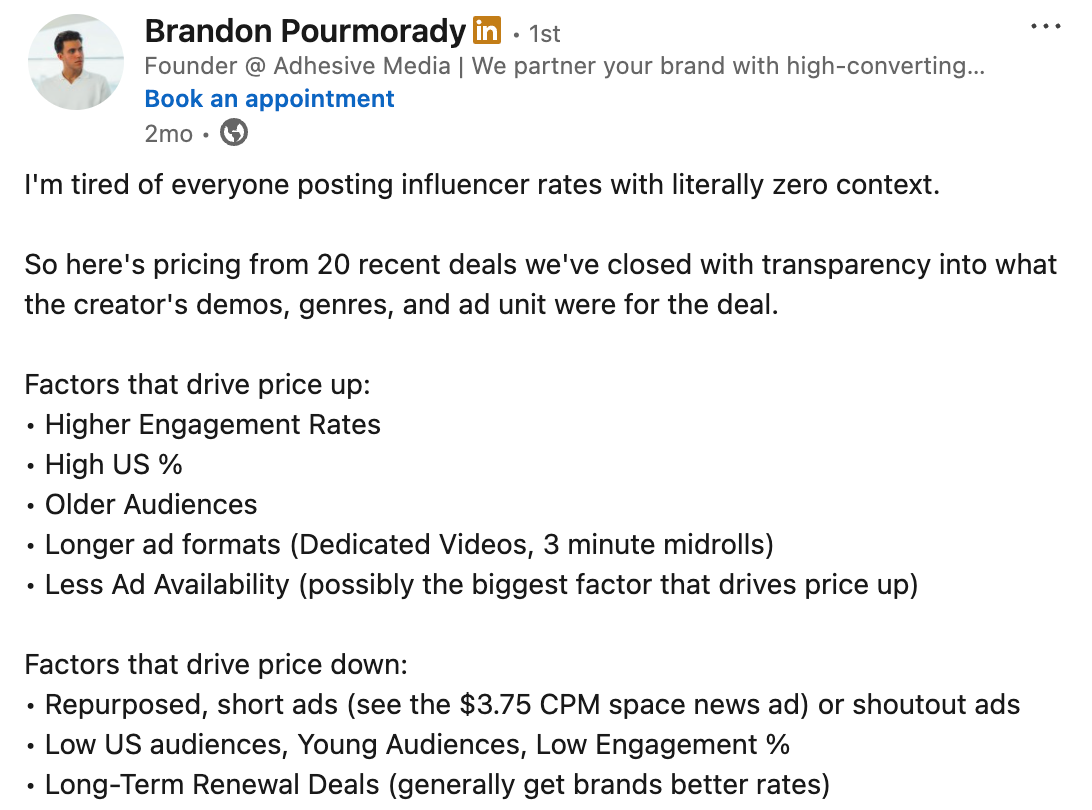
That said, if you want a reasonable estimation of roughly how much a YouTube video will cost for your brand, reach out to creators and build a database of quotes.
Most influencer marketers determine pricing based on an internal database of quotes, and it's much more reliable than generic industry estimates.
Types of YouTube Influencer Campaign Structures
There are plenty of different ways you can work with YouTubers, and here are the most common types of partnerships.
Affiliate Deals
An affiliate deal is an arrangement where a brand offers a creator a commission on any products the creator sells to their audience.
The brand typically provides the creator with a discount code or a unique tracking link to identify sales originating from the creator's audience. Then the creator earns a commission (often ranging from 15% to 20%) on the sale.
Here's an example of affiliate links:
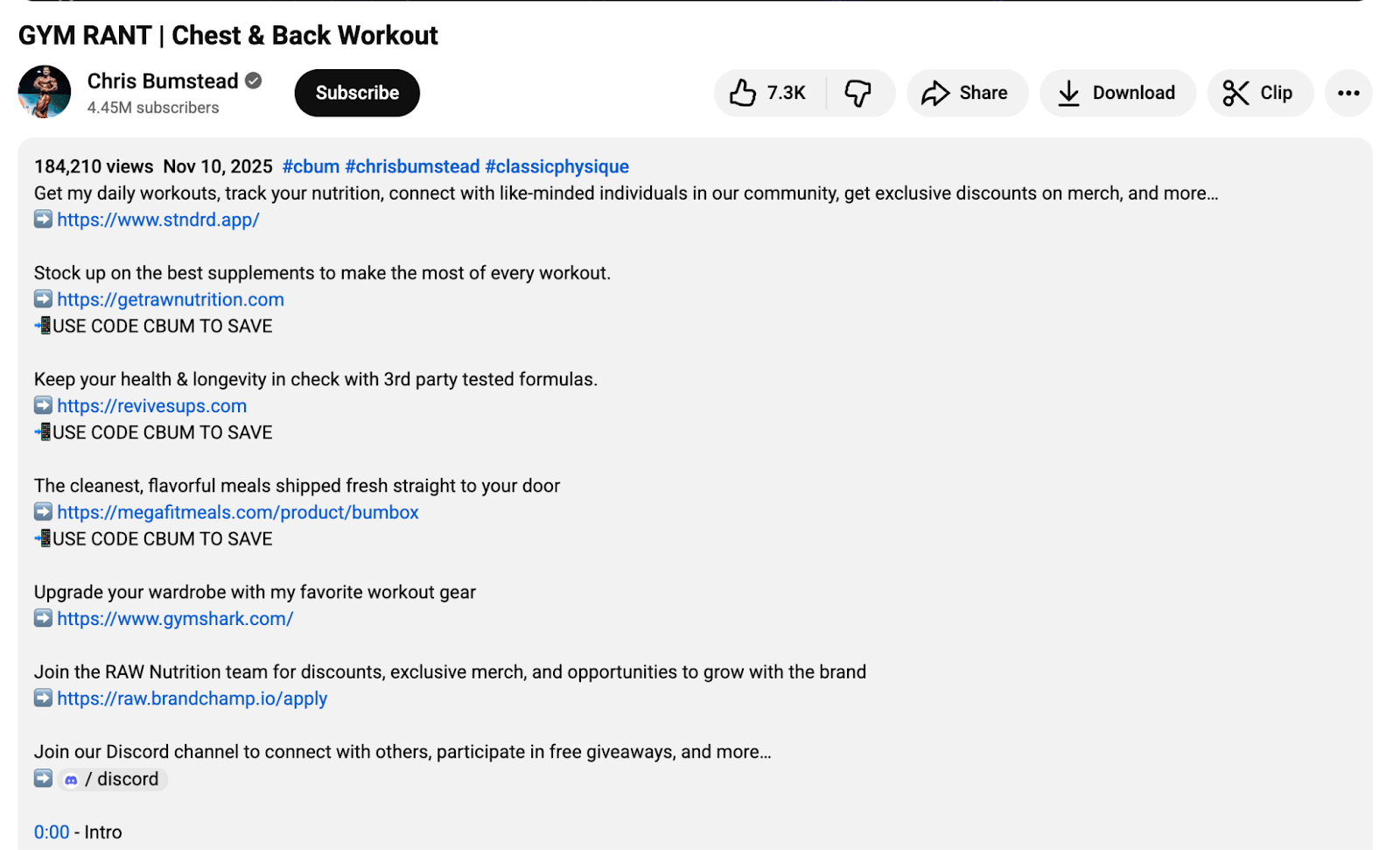
The benefit of affiliate marketing is that you don't have to pay the influencer upfront, as they only earn money when their audience purchases your product.
The downside of affiliate marketing is that you have very little control over how the influencer promotes your product and how much they'll promote it.
Often, influencers only include affiliate links in the video description, without mentioning them in the video itself.
You can encourage influencers to promote your product more by offering a limited-time increased affiliate commission, but most brands eventually transition to a more traditional influencer marketing strategy so they can control the promotion and brand positioning.
Video Integration
A video integration is when the creator takes a 30 to 90 second break to talk about a brand.
For example, at 16:00 into this video, you'll see that there's a video integration for a brand called Nebula:
The key to making a video integration effective is ensuring the pitch is integrated naturally with the rest of the video.
Specifically, avoid giving the creator a pre-written script and ensure the product is relevant to the video's topic.
The placement of the integration also impacts both performance and price. More people will see the integration if it's placed at the beginning of the video, but the creator will also likely charge more if the integration is placed at the beginning of the video.
Dedicated Product Video
Dedicated product videos exclusively discuss your product or compare it to other products in your market.
For example, here’s a dedicated product video done for Wix:

Many clothing brands also pay for "haul" videos featuring their products. Assuming the creator is only showing your brand's clothing, this is a form of a dedicated video.
For example, this Victoria's Secret haul video could be considered a dedicated video as it exclusively reviews that brand's products:

These videos convert very well and are therefore also the most expensive for brands.
Brand Ambassadors
In addition to typical sponsorship deals, brand ambassadors often have long-term contracts and create content at brand events, regularly promoting the brand on their channels.
BPN is a supplement company that exclusively does brand ambassador contracts with a select few influencers.
On the BPN YouTube channel, you'll see the same few athletes repeatedly featured in BPN's videos, and those athletes also post BPN content across their own social media channels.

Brand Equity
Many brands are also beginning to give YouTube influencers equity (ownership) in their company in exchange for promotion.
For example, tech YouTuber MKBHD joined the wallet company, Ridge, in a deal rumored to be approximately $1 million.

Magic Spoon is another example of a brand that grew with creators as partial owners.
However, instead of simply giving creators equity, the founders of Magic Spoon asked smaller creators to write checks for $5,000 to $25,000 to invest in the business before it launched. As investors in the business, these creators were then more than happy to promote it to their audience.
Here's a more detailed explanation of how Magic Spoon structured the deal with creators.
How To Run a YouTube Influencer Marketing Campaign
Once you’re ready to run a YouTube influencer campaign, here’s a step by step process.
Step 1: Define The Campaign Goals
Defining the campaign goal may seem elementary, but it’s essential to know whether your goal is:
- Brand awareness
- Conversions
- SEO/LLM visibility
For example, if the goal is to drive brand awareness, you might work with a general entertainment creator with a large following and ask them to do an entertaining video.
For example, David Protein Bars did a collaboration with Jesse James West for a video titled "I Tested Gyms That No One Goes To…"
You can see that the video itself is designed to simply entertain, and the integration occurs at approximately 10:13:
In contrast, if your goal is to drive sales, you might ask them to create a product review or haul video. For example, here's a haul video sponsored by Sephora:
If the goal is to rank for a high-converting keyword, ask the creator to make a video targeting that keyword and illustrate how to solve the problem using your product. For example, this video was sponsored by Durable (website builder) and ranks for the keyword "how to build a website." Throughout the video, they illustrate how to build a website using Durable as a tool to accomplish the task.
Here's another great example of a video that targets the keyword "The Best FREE Social Media Schedulers: Pros and Cons." It was sponsored by Metricool, one of the free social media scheduling tools.
Step 2: Identify Influencers
Once you determine the goal of your partnership, the next step is to identify influencers who align with both your brand and your goal.
First, let's start with your goal. Here are some guidelines depending on your goal:
| Goal | Criteria |
|---|---|
| Brand Awareness | Influencers with high view count in a niche that are in your industry or a parallel industry |
| Conversions | Influencers who match your ICP and have trust with their audience to influence their purchase decisions. |
| SEO/LLM Visibility |
Influencers who are in the niche of the keyword. It's important that the YouTuber you work with is an authority in that niche because YouTube's algorithm will only rank niche relevant YouTubers for the target keyword. For example, if you want to target the keyword "How to make money online," don't hire a gardening YouTuber to create a video on the topic (even if they use Shopify to make money online selling gardening supplies). |
To help you select the right creators, let’s walk through a few different real examples from brands.
Here’s an example of three different creators and videos for Shopify:
| Goal | Criteria |
|---|---|
|
Brand Awareness (High view count and in your industry or related industry) |
MrBeast: $10,000 Every Day You Survive In A Grocery Store: General entertainment YouTuber but also is a customer of Shopify. UpFlip: Candle Business Makes $300,000 In 18 Months! An ecommerce focused channel with a video topic relevant to the ICP. |
|
Conversions (Matches your ICP or their audience matches your ICP) |
Charlie Chang: The ONLY Shopify Tutorial You Need: A channel about how to make money online (matches the ICP perfectly) and the video showcases how to use the product (Shopify). |
|
SEO/LLM Visibility (Authoritative in the niche of the keyword you're targeting) |
Andy Stauring: How to Start an Ecommerce Business in 2025 (FREE COURSE): This influencer targets the keyword "how to start an ecommerce business" and is an authority in ecommerce. |
To give you an example of how this works for consumer brands, here are a few videos from Sephora:
| Goal | Criteria |
|---|---|
|
Brand Awareness (High view count and in your industry or related industry) |
As beauty is such a large niche, all of Sephora's creators for brand awareness videos are still in the beauty niche and create content relevant to beauty. |
|
Conversions (Matches your ICP or their audience matches your ICP) |
Sagonia Lazarof: HUGE sephora haul (viral makeup + skincare): This is a makeup and skincare channel that fits the ICP perfectly and has an audience that perfectly matches the ICP. It's a haul video, so it's designed for conversions. |
|
SEO/LLM Visibility (Authoritative in the niche of the keyword you're targeting) |
Amy Macedo: No Makeup Look Tutorial: "No Makeup Look" is a keyword and in this video, the beauty influencer walks through the step by step process of how to accomplish a no makeup look using the Sephora products. |
Next, you’ll have to decide whether you want to partner with a few macro influencers or many micro influencers.
The question that often arises is whether you should partner with micro or macro influencers.
Here’s a chart that summarizes the pros and cons of each:
| Factor | Micro Influencers | Macro Influencers |
|---|---|---|
| Cost | Total cost per campaign is lower, but cost per impression can be higher. | Total cost per campaign is higher but cost per impression can be lower. |
| Audience Loyalty | Often it's higher because there's more one-on-one audience communication | Often it's lower because there's more one-on-one audience communication |
| Niche Relevance | Often more niche relevant content | Often broader interest based content |
| Effectiveness | Great for selling niche relevant products, and testing specific markets | Great for general brand awareness and products that are relevant to a large percentage of people |
| LLM/SEO Impact |
Frequency of mentions increases (Good for LLM and SEO). However, they must have the niche authority to rank for the keyword. |
Frequency of mentions decreases (Bad for LLM and SEO). However, larger channels have more authority to rank for target keywords. |
| Best For | Brands targeting niche audiences or exploring new markets | Brands targeting mass-market or broad appeal products |
Therefore, both macro and micro YouTubers can be effective depending on your brand, audience, and campaign goals.
However, here are a few other factors to consider when selecting YouTubers:
- Upload Frequency: Ensure they're uploading consistently (e.g., at least twice per month for the past several months). If they haven't uploaded in a while, their audience might not be loyal.
- View Consistency: If they generate 100,000 views on one video and then 2,000 views on the next video, there's a chance that either their audience isn't very loyal, or your sponsored video will underperform.
- Content Authenticity: The creator is an extension of your brand, so you may need to avoid collaborating with controversial creators, depending on your company's values and image.
If you need help finding creators, you can use a platform like Favikon.
For example, you can simply type in something like “Beauty YouTubers in the United States with at least 10,000 followers:
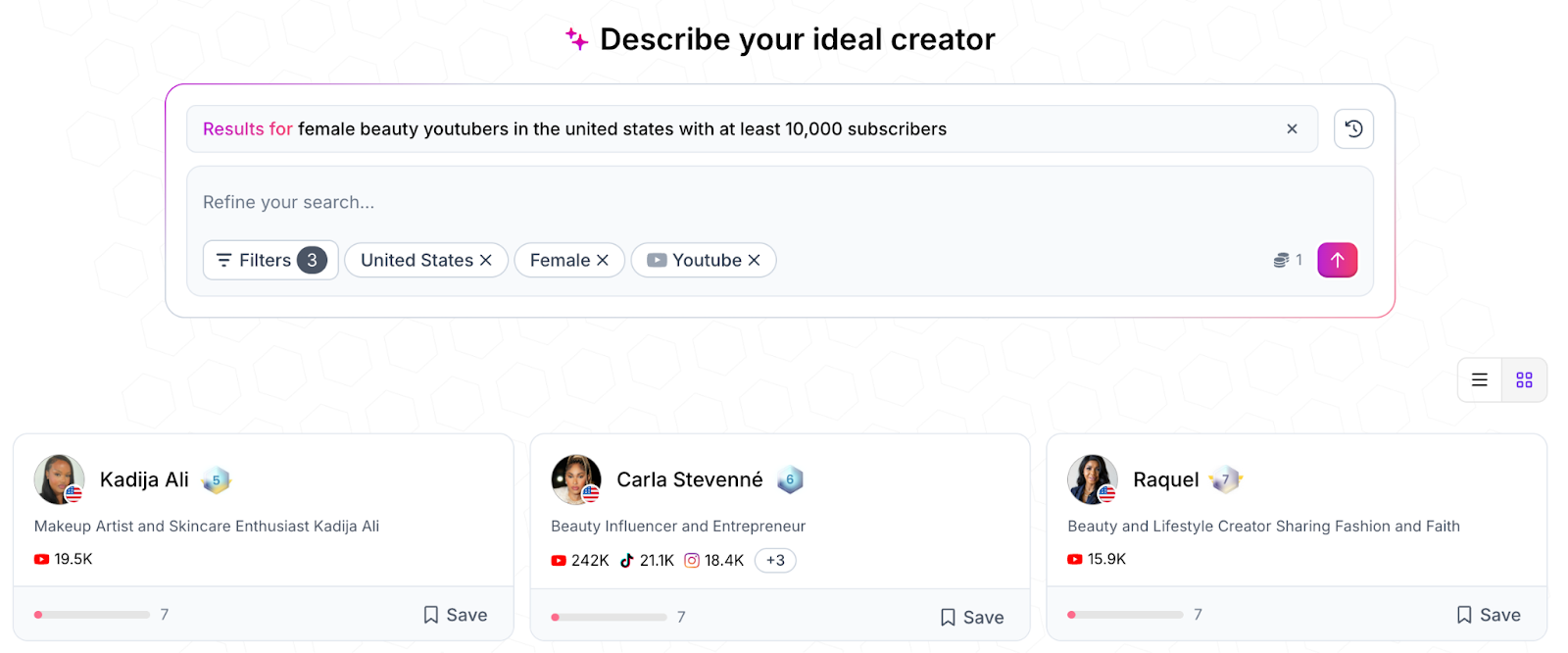
You can also explore more advanced filters, like follower count, growth, engagement rate, average views per video, and whether or not they are currently active:

Once you find a creator that interests you, click on their profile, and you'll see more engagement statistics:
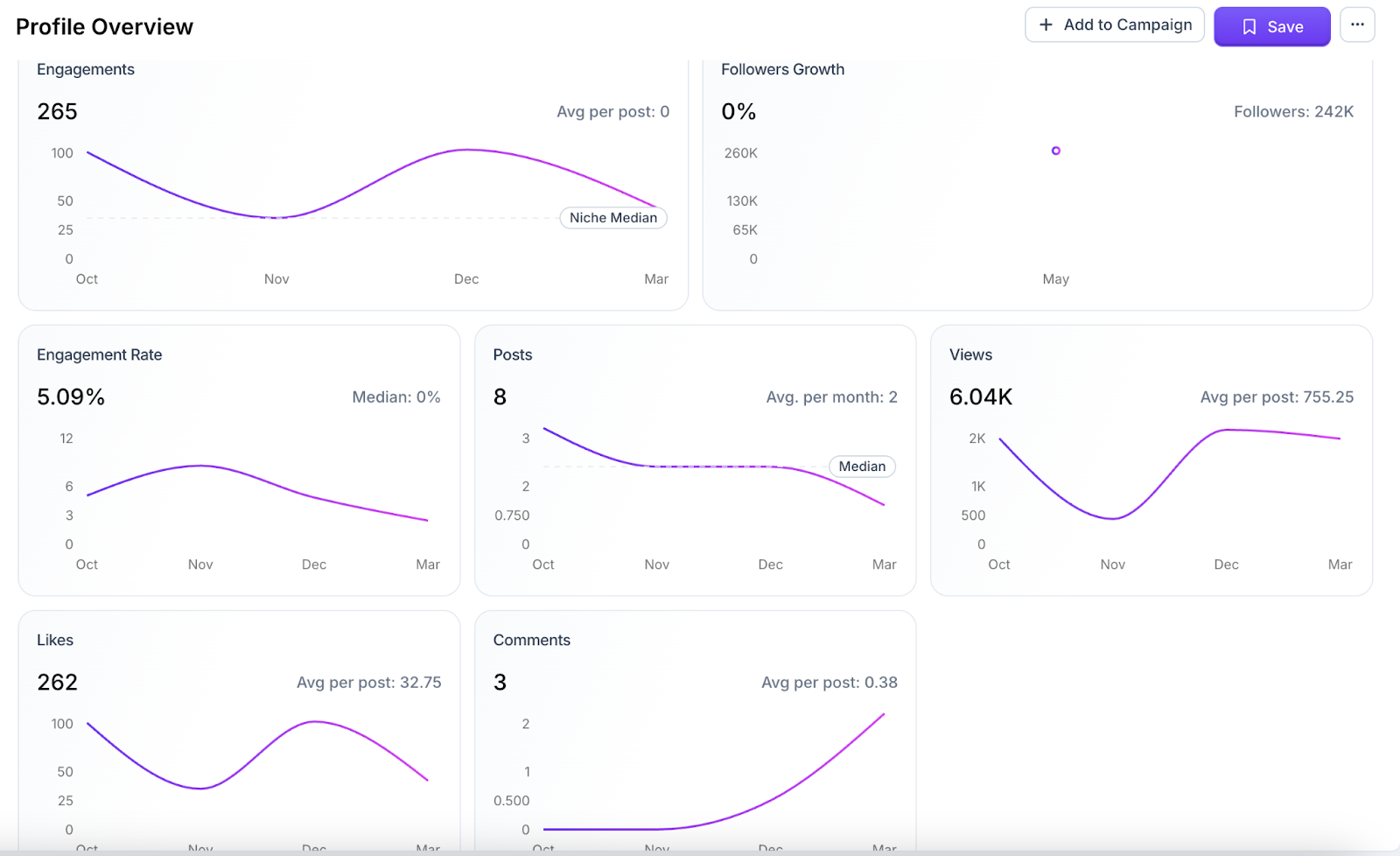
You can also see a list of the latest videos that they posted to see if their content aligns with your brand, and their latest content's performance, and whether it was published on YouTube Shorts or if it was a traditional long-form video:

Step 3: Influencer Outreach and Negotiation
YouTubers receive dozens of pitches daily, so getting a response can be surprisingly challenging.
First, try this trick that Alex Llull of Perspective uses, which yields an 80% response rate.
Simply leave a comment on their latest video saying, "Hey, I love your content. Would love to partner on a brand deal. Where can I contact you?"
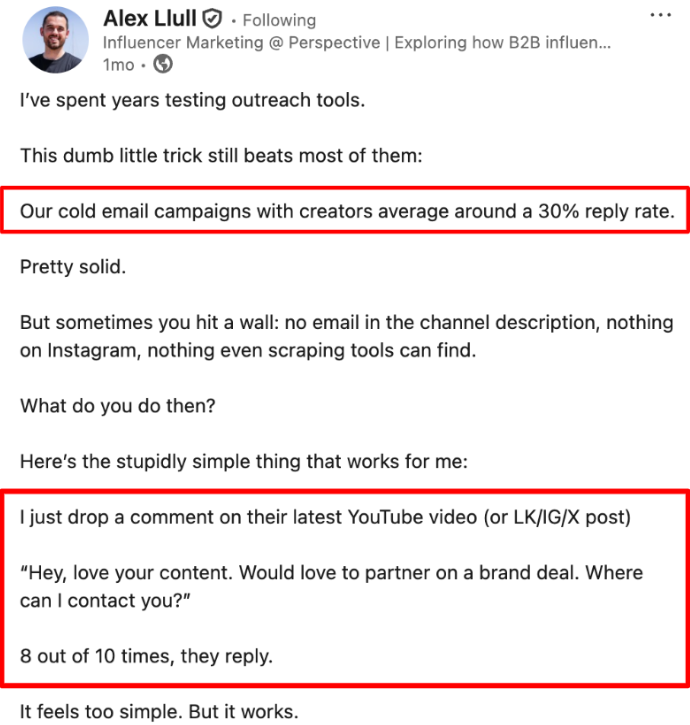
If that doesn't work, send a short, efficient pitch.
In this email, the goal of your first pitch should be nothing more than to simply receive a response from the creator.
Below is the exact pitch that Jeremy Barbara of doola uses, and he says it works because it doesn't offer any information that could immediately disqualify your brand.
"Hey, I handle influencer partnerships at (brand). I came across your page and think you're a great fit for our program. Let me know if you're interested in exploring."
Specifically, he says influencers don't respond to pitches because:
- Email is too long (this one is short)
- Budget too low (we don't mention budget in this outreach)
- Idea too boring (we don't mention the idea)
- Product is not a fit (we don't mention product details)

Avoiding asking for pricing information in the initial outreach message is arguably one of the most underrated tips.
Talent manager Saad Sarwar (co-founder of a talent management agency) shared that emails asking for pricing information are bucketed into a "likely less valuable" category and are therefore de-prioritized.
This is because emails asking for pricing information are often less serious and less invested.
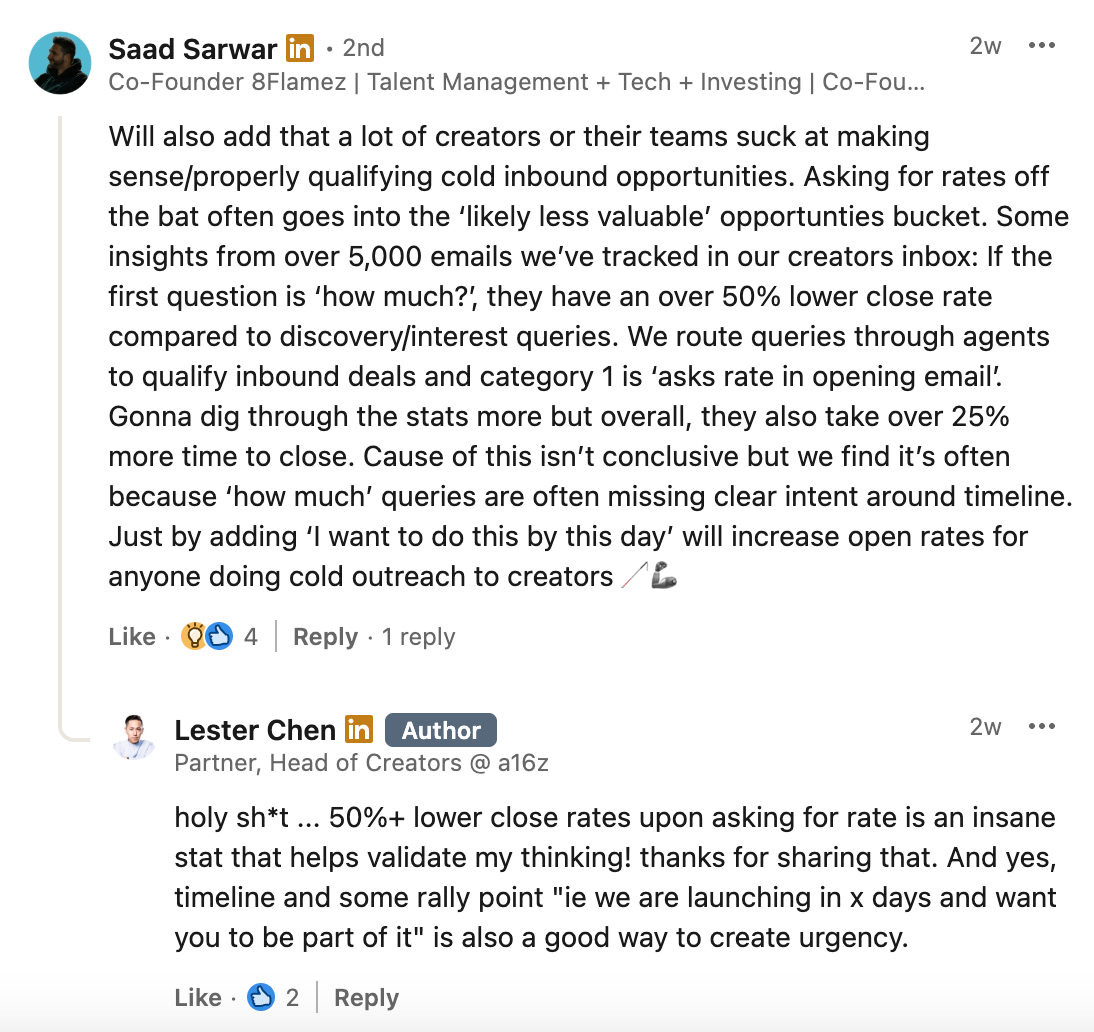
For more detailed information on how to master brand pitches, we have a comprehensive guide on influencer outreach.
After you've received a few responses, your next step is to negotiate pricing.
Unfortunately, pricing varies on YouTube. Brandon Pourmorady of Adhesive Media mentioned that pricing depends primarily on these factors:

He also shared some of the pricing data from his own deals:

Sarah Adam of Wix also shared some pricing data for dedicated videos:

If you've never run an influencer campaign before, consider collecting about 20+ quotes from creators in your industry and then use their averages to determine a reasonable base price to start negotiating.
However, as you begin the negotiation process, remember to always be respectful and polite, as influencer marketers often talk with one another.
In fact, here's a Reddit thread that proves this point, as one creator asked the group for feedback on partnering with Raycon, and the responses were less than supportive. The creator ultimately turned down the deal with Raycon:
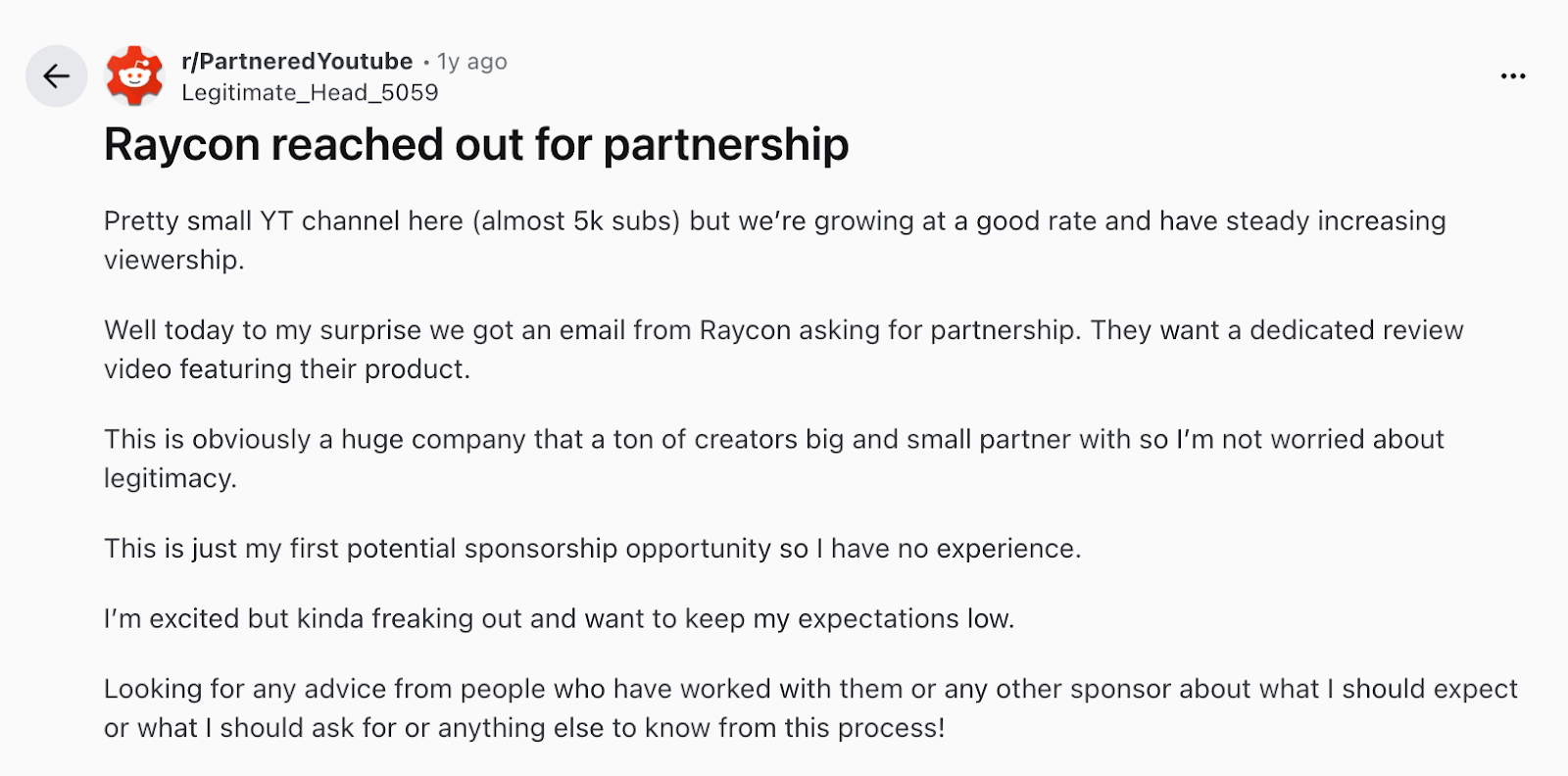
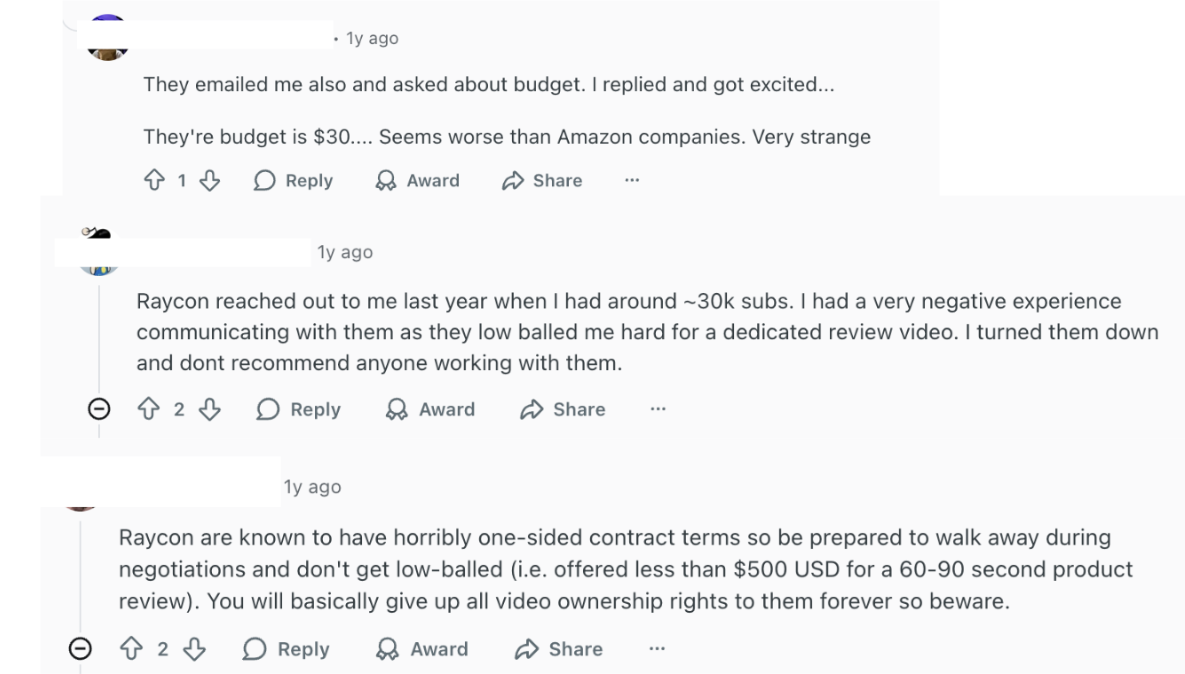
While it's impossible to please everyone, avoiding lowball offers will help you maintain a positive brand image among the creator community and allow you to work with your dream creators.
You'll also have to negotiate contract terms with your creators.
Jeremy Barbara of Doola recommends testing creators with a 30-day exclusivity contract, and then he enters a long-term partnership contract if the campaign performs well.
If you’re wondering what a good influencer contract looks like, here’s a guide from Adhesive Media. It primarily focuses on what a creator should look for in a contract, but the information is useful for brands as well.
Step 4: Campaign Ideation and Collaboration
If you're conducting a dedicated product review or want your video to rank for a specific keyword, the campaign ideation is already complete.
However, if you're running a one-off campaign designed to generate brand awareness, collaborate with the YouTuber to identify what will perform best.
A key mistake many influencer marketers make is giving the YouTuber a pre-written script or forcing a specific idea. Often, scripts written by the brand don't sound like authentic endorsements from the creator and therefore don't usually convert as well.
Additionally, creators know their audience best and will know how to frame the benefits of your product in a way that is most compelling to the audience.
So if you're doing a video integration, ask the influencer to simply share their experience with the product and talk about the key benefits they've experienced with it.
For example, Epidemic Sound sponsored Vanessa Lau to do the following video integration, and you can see that during the integration she walks the audience through her process of how she uses Epidemic Sound to add music to her YouTube videos:
You can also get creative with your product integrations.
For example, Lectic Bikes did a unique collaboration with Ryan Trahan where they offered to donate $10,000 to charity for every day that he rode the bike in his video.
Here’s a video of them discussing the challenge:
Step 5: Campaign Tracking
Most YouTube influencer marketers track views and engagement. You can also offer a discount code or unique tracking link.
However, brands often don't spend enough time thinking about the offer itself.
For example, if you're a B2B brand selling an enterprise product, don't pitch the core product directly because most enterprise buyers won't make a purchase decision the first time they hear about your product.
Instead, pitch a free tool or lead magnet so that you at least get users in your ecosystem, and then you can remarket to them.
This was a mistake the team at Ahrefs made in the beginning of their influencer program. During their first few campaigns, they pitched the core product directly, and very few people signed up for it.
So instead, Ahrefs started asking influencers to pitch their free Chrome Extension. The free Chrome Extension was a much more effective offer because it allowed Ahrefs to capture a higher percentage of viewers, and then they could later convert them through remarketing.
Here's an example of a partnership they did with Linus Tech Tips, where Linus pitches the free Chrome Extension.
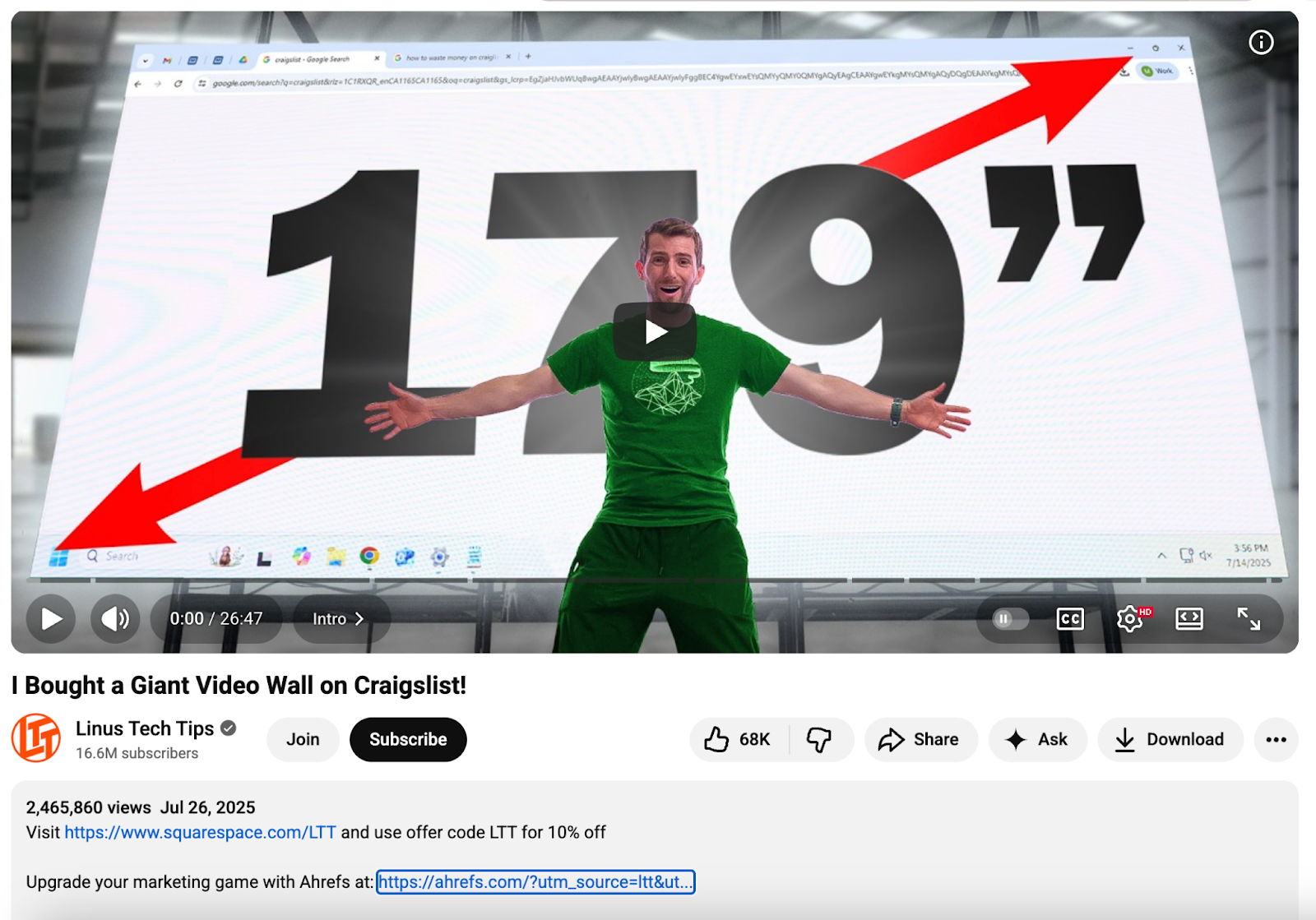
Another tip is to always send users to a dedicated landing page tailored to that creator. This tip is something that the Omnisend team always does, as it allows you to optimize the landing page to showcase testimonials from the creator.
For example, this is a video Omnisend sponsored:
And below, you’ll see that this is the landing page that the referral link leads to:

Finally, a tip Jeremy of doola mentioned is that it’s important to track performance over time rather than just the performance the first few weeks after the video was published:
This is important because YouTube is one of the few platforms where your performance can actually improve over time.
Start Your YouTube Influencer Marketing Campaign Today
The main challenges of YouTube influencer marketing are:
- Finding the right influencers to partner with.
- Outreach and managing collaboration communication.
- Tracking influencer content and approvals.
To solve these problems, we built Favikon. It’s an all-in-one influencer marketing platform that makes the collaboration process seamless.
Try Favikon today to learn how it can help you launch a successful YouTube marketing campaign.
Related Articles
See all the articles










